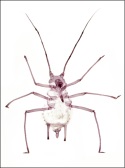Classification
Aphidinae: Macrosiphini
Diagnosis
Apterae are small to medium-sized, spindle-shaped, pale-yellowish green. The antennae have brown joints giving them a banded appearance (hence the common name "banded cereal aphid"), segment VI dark; siphunculi pale brown, legs and cauda pale. Alatae have a pale-green abdomen and dark-brown antennae and siphunculi. It is generally known to feed from under surface of the leaves, but also observed on the earhead in large numbers. Antennae longer than body. Processus terminalis 7-8 times longer than the base of last antennal segment. Siphunculi 0.13 times as long as body and 2-3 times longer than cauda. Cauda bears seven hairs.
Unlike other members of this genus, which always feed on the stalk of the earhead, this species feeds on the lamina of the leaves on the lower surface during nymphal stage and adults are seen on the earhead. This species differs from other species of this genus in having pale coloured knees of the apterae, paler siphunculi and longer processus terminalis.
Poaceae: Eleusine coracana (Linn.) Gaertn.
Host plant(s)
Aptera: Length of body 2.26, width 1.24; antennae 3.17, segments III: IV: V: VI 0.62: 0.61: 0.49: (0.14+1.09); u.r.s. 0.11; h.t.2 0.75; siphunculus 0.28; cauda 0.10.
Alata: Length of body 2.68, width 1.51; antennae 3.30, segments III: IV: V: VI 0.66: 0.60: 0.49: (0.15+1.16); u.r.s. 0.10; h.t.2 0.69; siphunculus 0.29; cauda 0.12.
Measurements
November-December.



